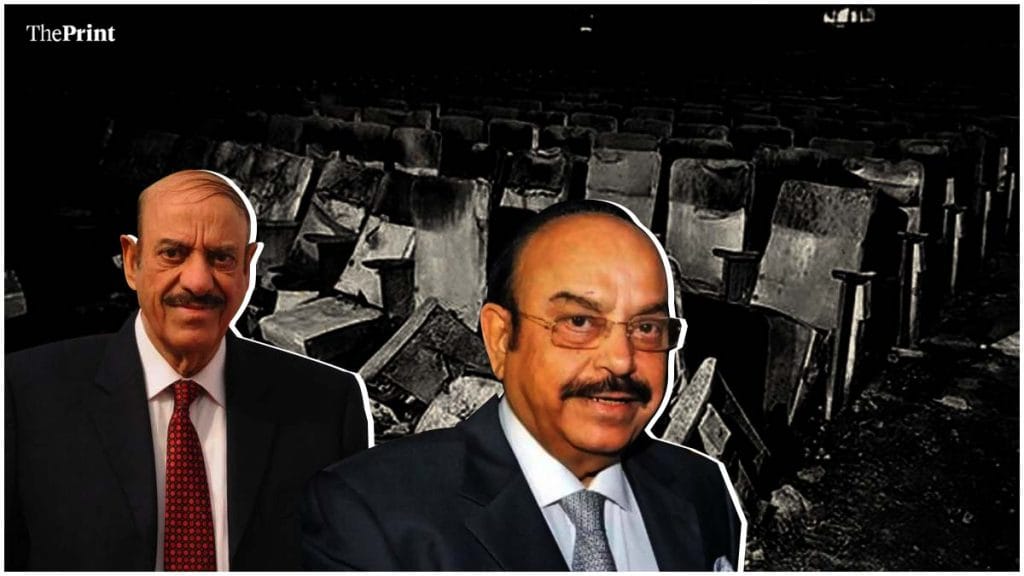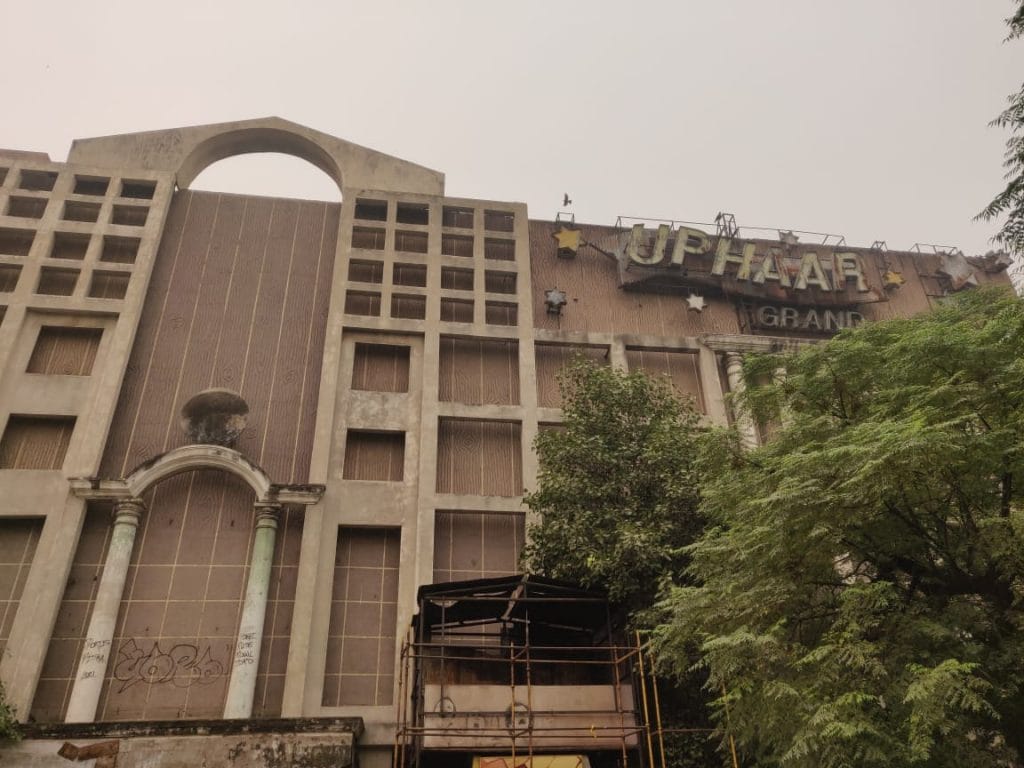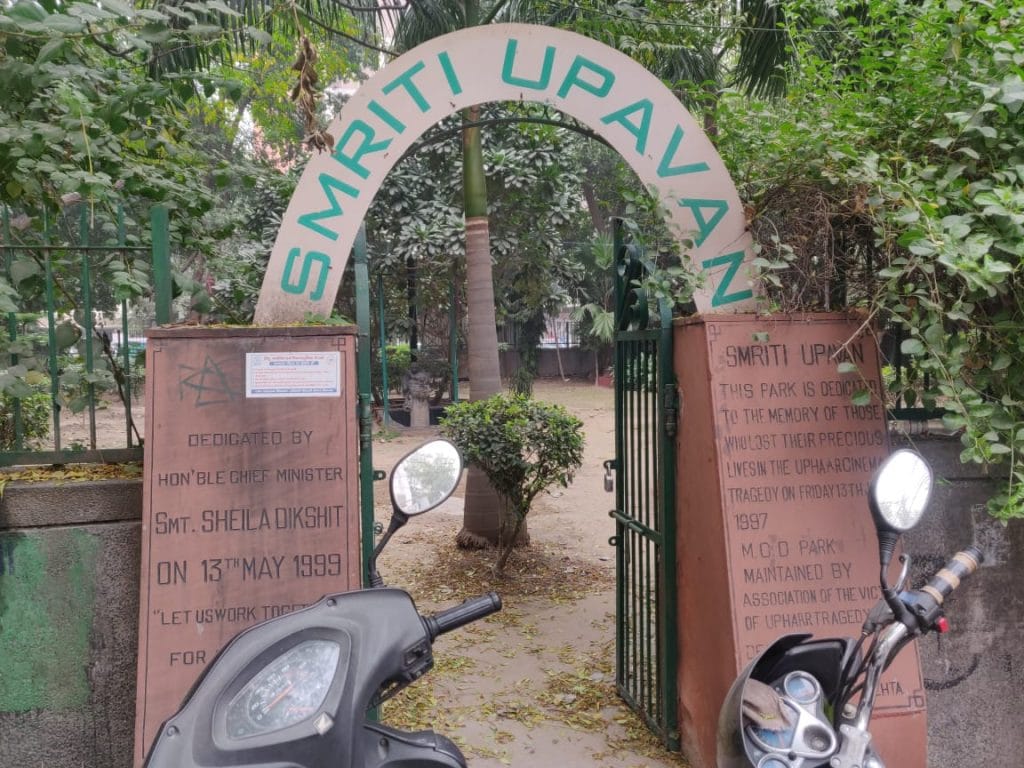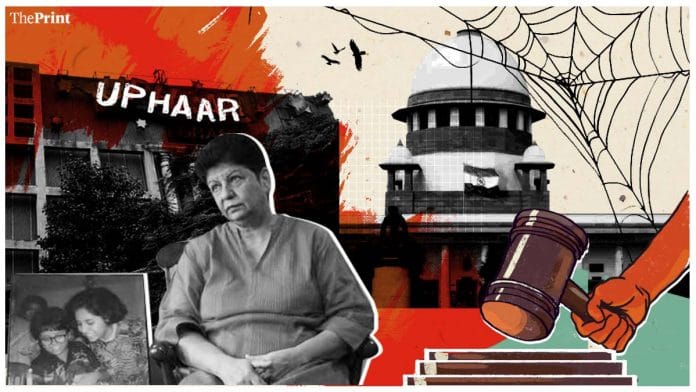PastForward is a deep research offering from ThePrint on issues from India’s modern history that continue to guide the present and determine the future. As William Faulkner famously said, “The past is never dead. It’s not even past.” Indians are now hungrier and curiouser to know what brought us to key issues of the day. Here is the link to the previous editions of PastForward on 1962 India-China war, J&K accession, caste census and Pokhran nuclear tests. For now, this is available immediately to all ThePrint readers.
Very soon PastForward will be among the premium offerings that go behind a paywall, only available to subscribers. As will Chinascope.
The twists and turns in the Uphaar Cinema fire court case read like a Bollywood plot.
Somebody poured ink on crucial documents. Signed cheques mysteriously went missing. A public prosecutor suddenly withdrew from the case on health grounds with no prior warning. It took 95 hearings for the charges against the Ansal brothers and the other accused to be framed. And in 2011, the Supreme Court drastically reduced the compensation the Ansals had to pay — even though the other guilty party, the Delhi Vidyut Board, had paid their full amount without complaint in 2003.
Lawyers tried every trick in the book.
Uphaar case warrior Neelam Krishnamoorthy couldn’t afford to lower her guard even for a day. And she still remembers the day she lost faith in the Supreme Court of India as clearly as the day she lost both her children in the fire.
On 13 June 1997, her children and the rest of the audience at Uphaar Cinema found themselves in a death trap while watching that year’s biggest Bollywood blockbuster, Border, during an afternoon screening. Since then, Neelam Krishnamoorthy and her husband Shekhar have not stepped foot in any movie theatre — and have become somewhat permanent fixtures at the courts instead.
The fire at Delhi’s posh Uphaar Cinema, owned by real estate giants Sushil and Gopal Ansal, took the lives of 59 people and injured 103 others. The Ansals were finally convicted to seven years in prison on 8 November 2021. The conviction follows 24 years of trials and tribulations.
Neelam and Shekhar’s fight was to not let justice fall through the cracks. It was never about the compensation money.
Also read: I lost my children in Uphaar fire. There’s no justice if mothers like me are let down
Fire, fate and the fight
“If there’s one thing I’ve learned from the last 24 years, it is this — don’t go to the courts with any expectations,” Neelam Krishnamoorthy told ThePrint. “They will let you down.”
Back in 1997, Neelam and Shekhar were legal novices, a far cry from the meticulous and sharp activists they are today. Neelam didn’t know the difference between a civil and criminal case when she first approached senior advocate K.T.S. Tulsi, but became so well-versed in the case that her lawyers relied on her to brief them before every hearing. Tulsi recommended a collective legal battle by contacting other victims’ families to form an association. He also insisted on representing the couple pro bono.
And so the Association for Victims of Uphaar Tragedy (AVUT) was formed. Neelam and Shekhar went through victims’ obituaries to reach out to their families, all of whom were still in shock. Over the years, more families got involved while others couldn’t keep up with the case. They were warned that the fight for justice would be long and hard, but none of them were prepared for the 24 years that would follow.
Judge after judge recused themselves due to association with the Ansals when the civil writ was being heard.

Also read: Ansal brothers get 7 years in jail for tampering with evidence in Uphaar fire case
The Ansals suddenly turned poor
The earliest legal outcome for AVUT was in 2003: The civil case actually became a landmark judgment because of the large compensation awarded.
The Delhi High Court, after considering the facts of the case and compensation given in other cases, awarded Rs 18 lakh each as compensation to adult victims, Rs 15 lakh each to families of the children who died, and Rs 1 lakh each to the 103 injured.
The compensation would have to be paid by the Ansal Theatre and Clubotels Limited (ATCL) group, the Delhi Vidyut Board (DVP), the Municipal Corporation of Delhi (MCD), and the Delhi Police. The Ansals were also directed to pay Rs 2.5 crore to set up a trauma centre. It stands today as the AIIMS Jai Prakash Narayan Apex Trauma Centre in Delhi’s Safdarjung Enclave, and is one of the few paramedical institutions in India.
The Ansals, however, filed an appeal almost immediately. They said they didn’t have the funds to pay the compensation, and requested control of Uphaar’s premises to raise the amount. The court denied them permission. In 2011, the Supreme Court responded to the Ansals’ appeal and reduced the amount to be paid to Rs 15 lakh for adults, and Rs 7.5 lakh for children.
It was never about money
But the civil case for monetary compensation, despite being a landmark judgment, is only part of the story. The real fight was taking place in the criminal case.
The Delhi Police arrested the Ansals in Mumbai in July 1997, but the case was swiftly transferred to the Central Bureau of Investigation (CBI). In her book Trial By Fire, Neelam wrote that the move took them by surprise. “While the Delhi Police had been consistently opposing the granting of bail for two weeks, the CBI, in the very first hearing, agreed to grant them [the Ansals] bail, even before it had taken charge of the case diaries from the Delhi Police,” she wrote.
The charges against the Ansals and the other accused were eventually framed after 95 hearings in the trial court in February 2001.
Also read: Fires across Delhi, including Sunday’s factory blaze, have killed over 70 people this year
‘Honey to heal wounds’
The criminal case progressed at a snail’s pace. The public prosecutor took them by surprise one morning when he withdrew from the case on health grounds. Former Solicitor General of India Harish Salve then appeared as a special public prosecutor for the CBI in all the appellate courts.
The Ansals, who were represented by veteran lawyer Ram Jethmalani, were also regularly requesting exemptions from appearing in court. One particular instance stands out: Sushil Ansal sought a personal exemption to attend a dinner honouring former US President Bill Clinton. At some point in court, Jethmalani offered AVUT more money as “soothing honey to heal their wounds.”
AVUT filed a petition in the Delhi High Court highlighting the delays in 2002. The High Court agreed to intervene and set December 2002 as the deadline to complete the trial — but it eventually ended in 2007, with all accused being convicted. By this point, only 12 people were convicted — four of the accused died during the 10-year trial. The High Court upheld the conviction in 2008 after 26 hearings.

Stay out of jail at any cost
The Ansals then appealed against the conviction in the Supreme Court in 2009. It was while the case was being heard in the top court that Neelam truly began to lose any lingering faith she had in the country’s judicial system.
On 19 August 2015, the Supreme Court sentenced the Ansals to two years of rigorous imprisonment.
But it also took note of the “advanced age” of the Ansals and said that the sentence would “stand reduced for the period already undergone” if they paid Rs 30 crore each within three months. That combined Rs 60 crore was supposed to go to another trauma centre in Dwarka, but it is unclear whether the funds have been dispersed.
The Ansals, who 10 years earlier didn’t have Rs 3 crore to pay as compensation to the victims, were able to furnish Rs 30 crore each for a year of freedom. But their desperation to stay out of jail eventually came at a much steeper price.
Files, cheques go missing
In 2006, while the case was still being heard at the trial court, an FIR was filed against the Ansals for tampering with crucial evidence.
Documents that “proved the financial and day-to-day involvement” of the Ansals in Uphaar Cinema until the day of the fire suddenly “went missing”. Some documents now had heavy ink stains, and important documents such as cheques signed by the Ansals were nowhere to be seen. The trial however proceeded with photocopies of those documents as secondary evidence.
This eventually became the Ansals’ downfall. The original case against them was of criminal negligence, but the tampering case showed criminal intent and was clearly premeditated — and this would require a more serious sentence.
“Tampering is a crime against the Supreme Court itself,” Neelam told ThePrint. “They were clearly trying to pervert the course of justice.” The Supreme Court reportedly termed it as “worse than murder and dacoity” in 2008.
Ultimately, it was this tampering case that led to the maximum possible sentencing of seven years, handed out earlier this month to the Ansals. Neelam has finally begun to feel “vindicated”.
Who was to blame?
The more important issue at hand was: Who was responsible and who should apologise? And why didn’t they?
The Ansals became a focal point in the case for their lack of acknowledgment—neither did they issue a public apology, nor take responsibility. Instead, after the June 1997 fire, the Ansals would maintain that they hadn’t been involved in running Uphaar since the late 1980s.
Nothing was farther from the truth.
Gopal Ansal, who was Managing Director of ATCL, used to say he did not want “even a nail to be put in the cinema premises without his prior permission”. There are also records of meetings in which he gave instructions regarding business decisions and day-to-day affairs of the company.

Also read: The lazy way to remember the Bhopal Gas tragedy
Uphaar and the Bhopal gas tragedy
In the immediate aftermath of the fire, the first blame went to management negligence. The transformer that caught fire at the cinema had been haphazardly fixed after a fire earlier that morning. Plus, it was in an already overcrowded parking space. Nobody alerted the audience after the fire broke out, and the cinema management head was missing when the disaster happened.
An initial inquiry by SDMC deputy commissioner Naresh Kumar charged the Delhi Vidyut Board, MCD, and Delhi Fire Service for allowing the construction of a mezzanine floor and increasing seating, thereby blocking the exits in the cinema hall. There were no emergency lights or announcement system either. The Ansal brothers were charged with “death by negligence.”
Then-Chief Minister of Delhi, Sahib Singh Verma, appointed another committee to fix responsibility. He promised to “arrest the Ansals if necessary”, but he could not say how soon action would be taken.
Many compared the Uphaar Cinema fire to the Bhopal gas tragedy, where a similar blame game took place. To people like Neelam Krishnamoorthy, it became typical of a case for passing the buck. The Uphaar tragedy victims and AVUT members were consistently expressing grievance against the ‘lesser guilty’ status given to the Ansals, questioning a vacuum of responsibility where the absence of concrete accountability structures led to a dilution of seriousness.
The emotional price
The Krishnamoorthys are still involved in multiple litigation, including a separate case against the Ansals’ employees for intimidating them and a case against Sushil Ansal for procuring a passport after misrepresenting details.
Going to court is such a part of Neelam and Shekhar’s routine now that they eat lunch after the court’s working hours at 6 PM. Between the two of them, they have mastered every document related to the case, from witness statements to building bylaws.
“We never plan for the future anymore. Every day, we wake up and only do what we need to do for our case,” said Neelam.
They knew the evidence was in their favour in the criminal case — the negligence was tragically obvious. The cinema’s announcement system wasn’t working, the exit doors were blocked by 37 extra seats installed for profit, the emergency lights weren’t functioning, the fire brigade was called 15 minutes after the fire took place…the list goes on.
Neelam says she was so disillusioned that she voiced all her grievances when the judge gave her an opportunity to speak in court one day. She was fully prepared to be held in contempt of court after she had spoken. But the order never came.
Vikas Pahwa, senior counsel to AVUT, had only started practising law a couple of years before his senior K.T.S. Tulsi took up the Uphaar case. He told ThePrint that had the Ansals been counselled to offer a proper apology, the case might have turned out differently.
“Both me and Shekhar were fearless. We had no fear of losing anything. We’d already lost the most precious things in our lives,” said Neelam.
Feeling safe in a cinema hall
Over the years, people have callously told the Krishnamoorthys to give up and move on. But they’ve been conserving their energy for their legal fight.
“As a mother, I get the strength to carry on from my children,” she said. “Whatever I’m doing is a tribute to my children. And I have to get justice for them. No parent should undergo what we’ve had to go through.”
Even during their interview with ThePrint, Neelam and Shekhar made no less than six calls to their legal team — they were keen to study the Ansals’ appeal against their conviction to prepare for their next trip to court.
According to Pahwa, it’s only because of the Uphaar judgment that we can feel comfortable in cinema halls today. The credit for implementing important safety protocols goes to the civil judgment, he says.
Martin Luther King Jr. at Uphaar
But Neelam Krishnamoorthy has set her sights on much-needed reform: She wants to campaign for the introduction of legislation on man-made disasters. This was something she had started in the early 2000s, but hasn’t been able to keep up with. The hope, she says, is that it becomes a blueprint to hold people accountable in case of disasters like Uphaar — which is something that’s missing from India’s legal framework.
Survivors of other fire tragedies like the 2010 Carlton Towers fire in Bengaluru and 2011 AMRI Hospital fire in Kolkata have reached out to Neelam and Shekhar Krishnamoorthy for support.
In the Carlton Towers case, which claimed nine lives, no trial has been held in 11 years. They don’t have a Neelam to push things in court for them.

The current Uphaar site in Green Park remains in a dilapidated state, following numerous failed attempts by the Ansals to sell the property. But right across Uphaar, surrounded by overcrowded parked vehicles and cloud kitchens, is a sign that says “Smriti Upavan” — an entrance to a tiny park memorialising the victims of the tragedy. Maintained by AVUT and inaugurated by then-Delhi CM Sheila Dikshit in 1999, the park stands as the only public memorial of Krishnamoorthys’ children and other victims.
A Martin Luther King Jr. quote is on a wall: No, no, we are not satisfied and will not be satisfied until justice rolls down like water and righteousness like a mighty stream.
(Edited by Neera Majumdar)






